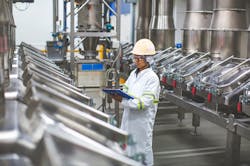Decarbonization is Overwhelming and yet Attainable: Taking Realistic, Efficient Steps Forward
When our children bring home their science packets from school, we see decarbonization defined as the reduction of carbon dioxide emissions. At their level, the process sounds simple, but for more than seven years now, leaders of nations and private companies have been exploring ways to decarbonize our world as outlined in the 2015 Paris Agreement.
A commonality among them: decarbonization is overwhelming.
For better or worse, fossil fuels power the world we have today. From the development of life-saving pharmaceuticals to the proliferation of everyday consumer goods, we now live in a world where global hunger has consistently dropped for decades, and life expectancies continue to rise—thanks to engineering advancements powered by fossil fuels.
But now that our climate is suffering, we must stand on the shoulders of the very technologies that brought us here and create a new path forward.
Electricity isn’t the only answer
Many shout electrification as the answer. While it is part of the overall solution, we are not at a place where we can switch all industrial thermal needs outright to electricity. For one, an industry-wide transition to electricity would be costly from a capital expense and operational expense standpoint. Electricity already can cost up to four times more than its fossil-fuel counterpart. Thermal needs within the industry can represent up to 50% of energy demand, which means that electrifying would also require a significant upgrade to a plant’s electrical infrastructure.
There is also simply not enough renewable energy available to satisfy the increasingly growing demand for renewable electricity. But with leaders from virtually all industry sectors pledging net-zero emissions goals for as early as 2040, where do we go from here?
Through my work in thermal utilities, and as President of the Americas at Armstrong International, I’ve learned that much of our emissions problems have less to do with the source of our energy than how we utilize that energy, or more precisely, how we waste it, particularly in the low-grade heat industry such as food, pharma and consumer goods.
Reducing Waste Heat in Facilities
Rather than waiting for a silver bullet renewable solution, we should be acting now to reduce waste and to put ourselves in a much better position to reach net-zero emissions once infrastructure and technology become sufficient and widely available. While this notion applies to all industries, using the food industry as an example, Armstrong has audited the thermal demands of hundreds of food processing plants, showing that they can achieve up to 50% total carbon reduction by recovering waste heat and thus decrease fossil-fuel demand accordingly.
This includes de-steaming (conversion to hot water loops) all applications below 250°F; recovering direct heat whenever possible through heat exchangers; and using industrial high temperature heat pumps for raising the temperature of low-grade heat to the level that is useful for the process (up to 250°F).
In some cases, where higher temperature applications exist, the system cannot be completely de-steamed, and some localized steam generation will continue to exist. This steam can potentially be generated by a high temperature heat pump or a localized steam generator using renewable energy.
It’s simply about optimizing a well-working system to reuse, rather than allowing waste to creep out. This is a no-regret, first step into the decarbonization world, and the best place to get started, because whether or not the goal is complete decarbonization, this process has positive return on investment.
This approach allows plants to significantly advance toward carbon reduction goals while then being well positioned for the ultimate decarbonization of the remaining generation of thermal utilities by switching to renewable primary energy. This ultimate decarbonization often happens through electrification, and most of the time will come at a negative return of investment due to increased operating expenses.
For plants that have implemented such a switch for the sake of speed and simplicity, applying this methodology afterward results in a very low payback, as it allows the plants to significantly reduce the renewable energy bill. Additionally, it allows the factory to conserve the renewable energy that the rest of the society will need for the decarbonization of sectors in which waste heat is not available.
This methodology closely follows the reduce, reuse and replace model, which is more familiar to most publics. When starting this process, we recommend beginning with a thermal mapping study, which provides an understanding of how energy is used and wasted in the facility. It quantifies and maps all heat sources and heat sinks of the facility.
Food manufacturing facilities can use thermal mapping to identify many low-hanging opportunities. And for those with older steam systems, and plants that do not have metering of thermal utilities to develop a baseline, it is possible to use temporary meters to create an energy picture of the plant.
Pinch Analysis – and Underutilized and Effective Way to Optimize Energy
Pinch Analysis, widely used in chemical and petroleum refining, maps out the energy flow in a facility, allowing the engineer to visualize the optimum energy recovery solution and shows the ideal minimal required energy for a plant. While this analysis suggests the best theoretical combination of heat sinks and heat sources, it often requires an experienced engineer to translate into a practical solution for the plant – taking into consideration not only temperature levels, but also process timing and location.
The most fascinating thing about the pinch analysis is how infrequently it is used outside heavy, extremely thermal intensive processing industries. It is a very reliable tool for those who know how to use it, and it produces impressive results for those looking to decarbonize their industrial factory. The difference between using pinch and its associated golden rules or not can translate to up to twice as much energy recovered.
Furthermore, pinch greatly facilitates decision making, as it helps to identify the single best solution from a thermodynamic standpoint, which can then be applied to the plant in a practical manner. While doing work at the chocolate factory, we used the pinch analysis to inform the design of a new heat exchanger network recovering most of the low-grade heat in the facility.
Decarbonization is attainable
Through the implementation of materials collected by both thermal mapping and pinch analysis, companies are in a place to save money and uphold goals set for their organizations. As these methods already exist, anyone using them has the capability to start down their own path of thermal decarbonization. Simply attaining these first two parallel steps of minimize and optimize puts leaders in a place of forward thinking, forward motion, and on the path toward net-zero emissions.
There certainly is a lot to know about decarbonization, especially for industry leaders who are looking for a process that is attainable with limited resources and knowledge. This is the real world, not an elementary school science class, but it can be as simple if we know where to start.
About the author: Patricia Provot is Armstrong International’s president of the Americas. Under her leadership, every client gets the optimal solution to fit their needs. Today, Patricia is heavily involved in product innovations, growing the next generation of energy auditors, standardizing Armstrong’s methodology and pursuing the company’s carbon-cutting initiatives.
About the Author
Patricia Provot, President of the Americas at Armstrong International
From LinkedIn: Patricia Provot is president of Armstrong International’s North America operations. She began her career at Armstrong in 2000 as an energy auditor in Belgium after receiving a master’s degree in Chemical Engineering from Haute École (de la Communauté Française) "Paul-Henri Spaak” in Brussels, Belgium.The opportunity to help customers streamline their goals, provide them with practical solutions and execute realistic plans are what drew her to the energy auditor role. Even after two decades, Patricia’s client-centric priorities have never swayed: “I always want to make sure we give clients the savings we promised.”Patricia also understands there is no one-size-fits-all approach to every customer. She believes there is a best solution for every client, from energy savings to ease of use. Under her leadership, every North American client gets the optimal solution to fit their needs.During her time at Armstrong, Patricia has served clients and assisted teams across the United States, Belgium, India, China, the Philippines and more. Her international experience, knowledge of heating solutions, auditing expertise and natural born leadership skills led her to her current role as president of Armstrong’s North America operations since 2017. Given her 20-year tenure at the company, she continues to connect with team members across all levels, providing guidance and support where needed.Today, Patricia is heavily involved in product innovations, growing the next generation of energy auditors, standardizing Armstrong’s methodology and pursuing the company’s carbon-cutting initiatives. She looks forward to working with both longtime North American companies and innovative startups alike to provide the right solutions for every client.

